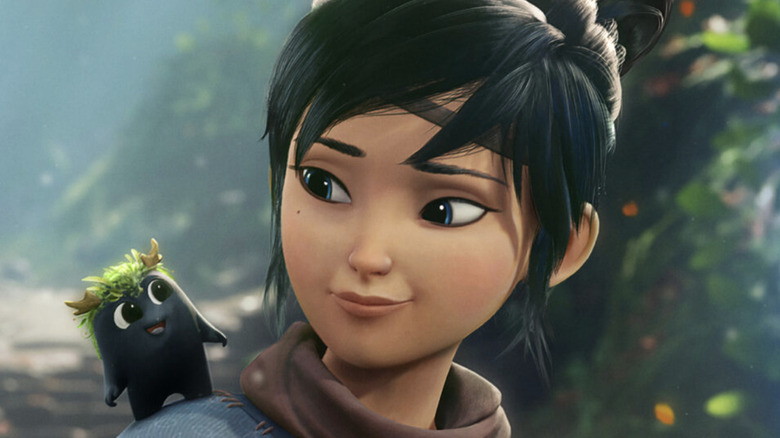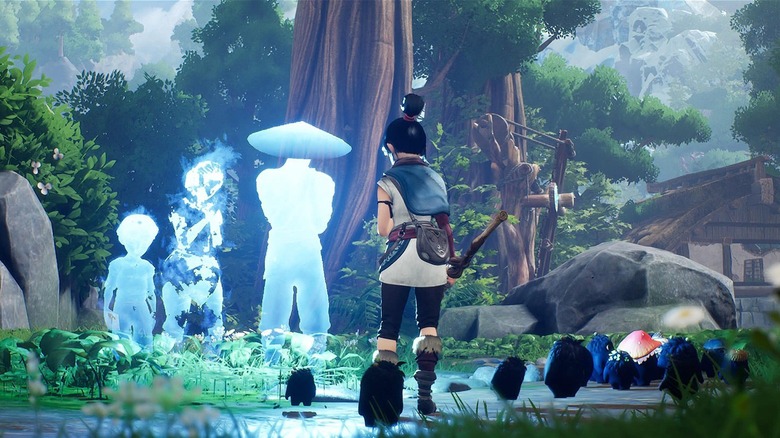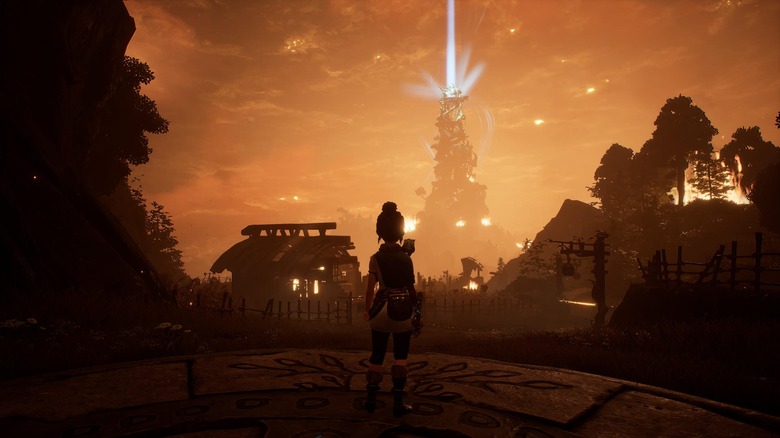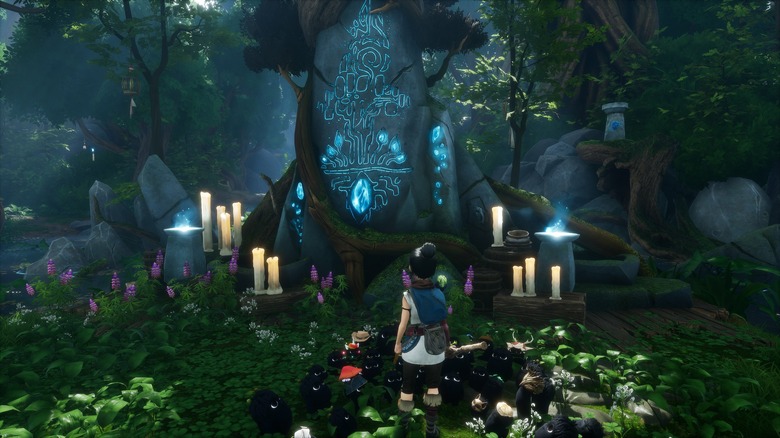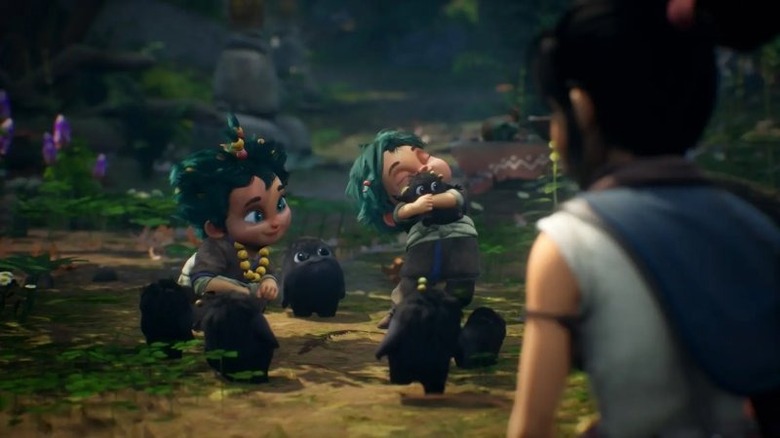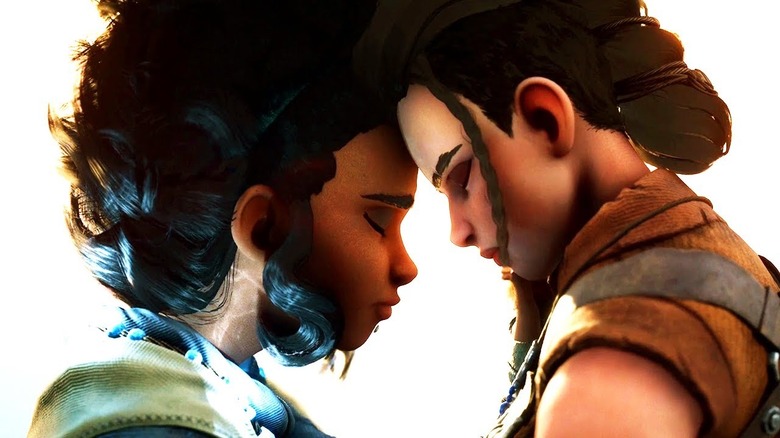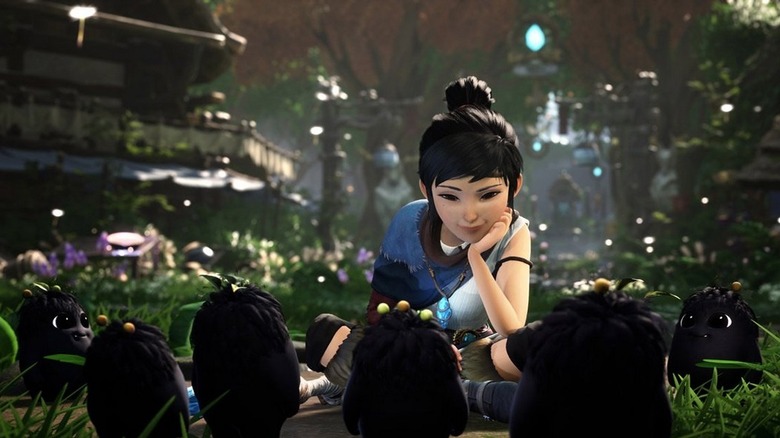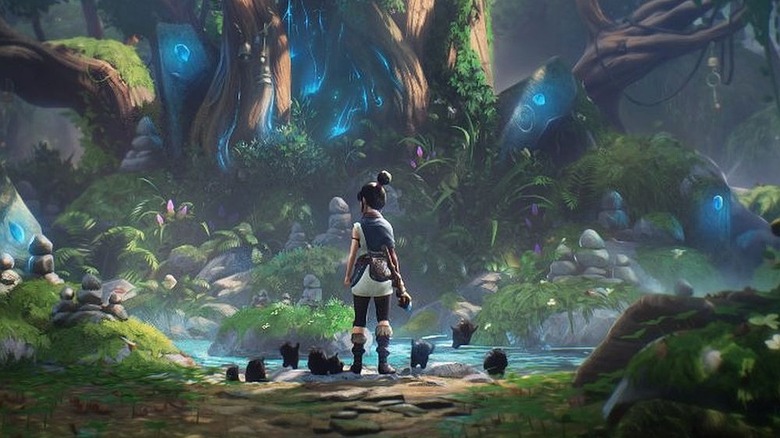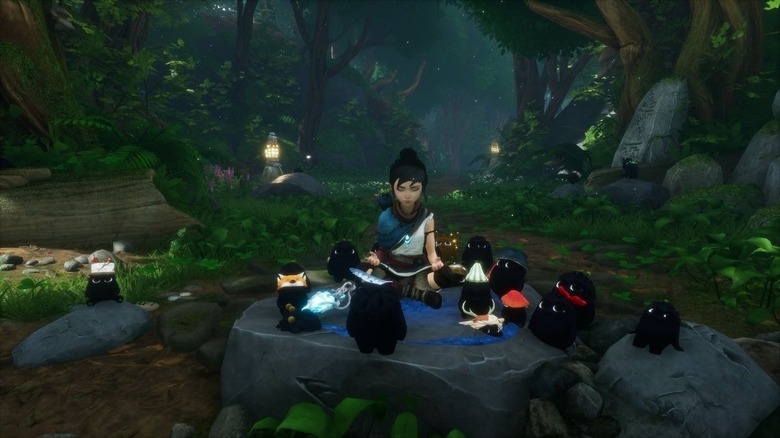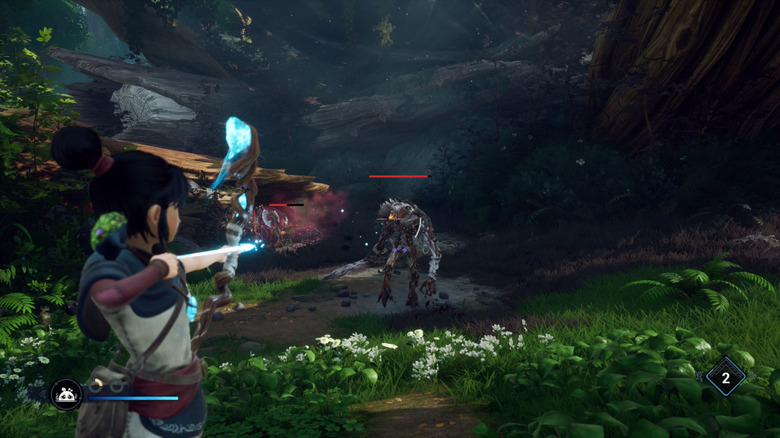Things Only Adults Notice In Kena: Bridge Of Spirits
"Kena: Bridge of Spirits" is a new action-adventure game, the first foray into video games by Ember Lab, an animation studio perhaps best known for its viral short film based on "The Legend of Zelda: Majora's Mask." In "Kena," the player controls the titular character, a spirit guide tasked with guiding lost souls to their final resting place. Eventually, Kena stumbles upon a corrupted and abandoned village at the base of a mountain, which houses a spirit shrine Kena is attempting to reach. In order to get there, she must first do her duty and put the agitated souls of the village to rest.
Along the way, Kena encounters the Rot, nature spirits that assist her in defeating the land's corruption and angry spirits. The adorable creatures are a great asset to Kena, and play an important part in the game as well. While critics have found that the cute characters and generally bloodless action gameplay make "Kena" the perfect family-friendly experience, there are a few key takeaways that will most likely only be picked up by adults. In fact, the story and themes of the game seemed to be the most important aspect of its development.
As Ember Lab co-founder Mike Grier told Soul Vision Magazine, "[Kena] deals with people struggling with loss or struggling with a mistake they made ... I hope people connect with the story and the themes of the game as much as the gameplay." But what exactly are some those themes Grier may be talking about?
Beware of spoilers ahead for "Kena: Bridge of Spirits."
Kena focuses on death and the afterlife
One of the main themes throughout "Kena: Bridge of Spirits" is, unsurprisingly, that of death and the afterlife. However, what might be a shock to some people is just how unflinchingly the game looks at these concepts.
In "Kena," the protagonist comes upon a desolate village that has been corrupted by malevolent spirits. In a traditional three-act gameplay setup (along with a prologue), the player encounters three agitated spirits and must calm them down to gain access to the sacred mountain. However, these spirits aren't just agitated for no reason. The game focuses specifically on the ideas of loss and finally learning to let go. It also concentrates on the existence of an afterlife in general.
Although the game exists in a nebulous environment (neither the village or Kena's homeland is ever named for the player), it does establish the idea of spirits and a type of religion quite strongly. The village had a mask-maker who crafted masks for the deceased, and the masks only disappear once the spirit has fully moved on from their world. These masks play a big part in the plot of "Kena," and the dissolving of the masks is used throughout the plot to signify the peaceful passing of a spirit.
Kena: Bridge of Spirits is an environmental allegory
Although "Kena: Bridge of Spirits" focuses a lot on death, the game also delves quite deeply into the living world — specifically when it comes to environmental concerns. The entire second act of the game is devoted to the idea of environmental degradation, focusing on a corrupted spirit that destroyed the ecosystem of her home while alive. By overusing and destroying the environment, the spirit ended up tethered to the destruction she caused. She is only able to move on once she makes peace with her actions and finds balance with the world around her.
Aside from this section of the game, environmental concerns are also peppered throughout the main storyline. Kena first encounters the Rot, nature spirits, because she exists in a state of harmony with the world around her. Additionally, players learn that the final spirit of the game — the village leader named Toshi — actually caused the village's destruction, and he did so because the environment of the mountain was changing, thanks to the actions of the Rot God. While the village elder, Zajuro, tried to convince Toshi that change and decay is a natural part of life, Toshi tried to take matters into his own hands, destroying the ancient spirit on the mountain — which ultimately brought ruin to his home.
Kena is heavily influenced by Southeast Asian culture
Mike Grier, one of the founders of Ember Labs, which created "Kena: Bridge of Spirits," has cited his time in Asia as an influence for the video game's story and aesthetic. He lived in Tokyo for three years when he was younger, and Grier told Soul Vision Magazine that this experience helped shape some of the creative choices he made in "Kena."
Specifically, the architecture and environments in "Kena" seem to be greatly influenced by Japanese culture, including the use of traditional lanterns and the appearance of what looks to be a cherry blossom tree in one of the game's areas.
Balinese culture is heavily drawn upon in "Kena," as well. The idea of carved wooden masks housing spirits is directly taken from this culture (via The Culture Trip), and is a core concept that is heavily featured in the game. The music used in the game's score is also mainly Balinese or Balinese-inspired. In fact, the game's composer, Jason Gallaty, closely collaborated with Balinese ensemble Gamelan Çudamani to create a traditional sound for the game.
According to Game Informer, Grier and Gallaty even traveled to Bali to record some of the songs, because the traditional bamboo-style instruments needed to create the music would be too complicated to transport to the United States. The result of this collaboration is a gorgeous soundtrack that really serves to immerse the player in the environment.
Kena discusses the pressures of responsibility
While each of the corrupted spirits the player encounters in "Kena: Bridge of Spirits" is unique in their own situations and problems, they do have a few things in common. Specifically, each of the spirits seem to have succumbed to the pressures they were facing in life. Throughout the three acts, Kena faces an older brother (Taro), a master inventor (Adira), and the village leader (Toshi). During their lives, they all became overwhelmed by the responsibilities they had to those around them. Taro had to care for his younger siblings after their parents died. When the storms came, however, he lost them in the forest, and his guilt over his perceived failure to protect them ultimately drove his spirit to corruption.
Adira and Toshi had similar fates. Both believed they should have been able to save the village in their own way: Adira believed she should have been able to harness the power of the mountain to protect the village, and Toshi refused to move their home because he felt a responsibility to the land. Adira also didn't want to leave the home she had built because it was the only place her partner, Hana, would look for her. Moving would spell defeat in their eyes, something neither Adira nor Toshi could allow. Ultimately, their stubbornness in the face of this responsibility led to the corruption of their own spirits.
Kena: Bridge of Spirits is ultimately about forgiveness
The key takeaway from "Kena: Bridge of Spirits" is that forgiveness is essential in life. However, the game doesn't really focus on the forgiveness of others. While each corrupted spirit does have a non-corrupted spirit that was their friend in life (Taro has his siblings, Adira has Hana, and Toshi has his mentor), those non-corrupted spirits had forgiven their friends long ago. What Kena has to do is discover the corrupted spirits' fear, love, and regret, which will ultimately allow them to understand just what it is that has caused them to become corrupted.
At the end of each act (and the game), the corrupted spirits return to their uncorrupted selves, and their friends come to reunite with them. Along with Kena, they must convince the once-corrupted spirits that what they did wasn't so terrible. In order to move on and find peace within themselves, they must first acknowledge that what happened was out of their control — and they have to forgive themselves.
Only by facing the events near the end of their lives with self-acceptance and grace is a spirit able to finally shed whatever is keeping it tethered to the living world. Ultimately, Kena and the spirit friends are able to show the other spirits their regrets, but also their love, and use this as a catalyst to allow them to move on. Forgiveness — both from without and within — is the key.
Kena ackowledges those left behind after death
Even though a big focus of "Kena: Bridge of Spirits" is on death and spirits, almost equal attention is paid to those who are left behind in the world of the living. Although it is somewhat relegated to the background of the plot, Kena's own personal quest does get addressed throughout the game, especially towards the end of the story. Kena discovers the abandoned village on her search for the sacred mountain shrine, which was an extremely special place for her late father. Her father was also a spirit guide, and Kena has long hoped that, by returning to the sacred mountain shrine, she'll be able to feel closer to her father.
This recurring element of loved ones affecting those they left behind is also prevalent throughout Kena's interactions with the spirits. She even mentions to the village elder's spirit that she will miss the spirits who cross over, even though it's a necessary step.
Those who are left behind are affected just as much by someone's death as they were by their life. This concept is also physically manifested in the game world by the existence of the corrupted environment. The negative energy from those corrupted spirits was so strong that it bled over into the real world, adversely affecting the lives of those left behind.
Kena: Bridge of Spirits explains that moving on is not forgetting
As a spirit guide, Kena helps spirits move on. However, that is not the only form of letting go that the game focuses on. The game also explores the idea that moving forward isn't the same thing as forgetting about something — or someone. This concept is also during the game's central plotline.
In one instance, the village leader, Toshi, complains about the failing land around the village. When Zajuro tells him that this means it's time to move to a new location and that their home is wherever their people are, Toshi refused, ultimately leading to the village's destruction. This line of thinking is echoed in the plotline of Adira. She did not want to leave her home either, fearing her companion Hana would not be able to find her way back if she left her physical location. What they didn't understand was that this didn't mean they had to forget about where they came from.
The game also points to this idea with the Rot, Kena's nature spirit companions. At the end of the game, the player finds out the Rot are small manifestations of the nature spirit that guarded the mountain and whom Toshi destroyed in a rage. Eventually, Kena tells the Rot it's okay for them to leave her, and they do, slowly reforming in the image of the nature god. The player is left with the idea that it does not matter if something leaves them, their mere existence affects them in way that means they will never be forgotten, meaning they're never truly gone.
Kena points to the benefits of meditation and doing good deeds
One of the most accurate (and oddly amusing) parts of "Kena: Bridge of Spirits" is the way in which the main character levels up and can increase their stats. By doing good things throughout the land, like cleaning altars and righting broken status, Kena can gain Karma, which can be spent to increase her abilities. This is a direct parallel to how the player should perhaps act in life. Should the player treat the environment and those around them with kindness and respect, they will gain good Karma, which can potentially help them better navigate the real world.
Additionally, there are no stats in "Kena," apart from the title character's health bar. The only way the player can permanently increase the size of this bar is by finding mediation spots hidden throughout the game. This feels like the game basically telling the player, "Meditation is good for you." Fans have noted that the game's music has made them want to meditate, so it seems like the design of the game is working as intended.
The existence of meditation in the world also ties directly back into the game's themes of harmony and the ability to just let go. In fact, the last thing the player can do in game before the credits roll is meditate, with the assumption being that Kena has at last followed her own advice, and is finally at peace with her father's death.
Kena: Bridge of Spirits is similar to another Playstation/PC exclusive
"Kena: Bridge of Spirits" is an absolute joy to play, earning excellent reviews thanks to its cute characters, thrilling combat, and a beautiful environment, so it's probably no surprise that it brings to mind another fantastic Playstation/PC-exclusive game, "Horizon Zero Dawn." For those who need a quick refresher on Guerilla Games' most recent action-adventure game, "Horizon Zero Dawn" follows the exploits of Aloy and her quest to rid the world of the corruption of the machine animals found throughout the game.
Aloy does eventually stumble into a larger story, but at their foundations, "Horizon Zero Dawn" and "Kena" are quite similar. Aside from comparably gorgeous environments and music, some of the gameplay mechanics are the same. Kena and Aloy make use of many of the same weapons (bow, spear, and bombs). Both games also feature similar yellow/white markings and symbols used on cliffs to tell the player where to climb, and of course, both star singular female protagonists. Publications like Trending News Buzz have pointed out the similarities between the titles, which illustrate a continued boom in new female-driven action-adventure stories (via Wired).
The success of games like "Horizon Zero Dawn" and "Kena" — and the hype surrounding "Horizon: Forbidden West" — indicate that not only are female protagonists able to hold their own as singular player options, they are also capable leads in exciting and beautiful games.

